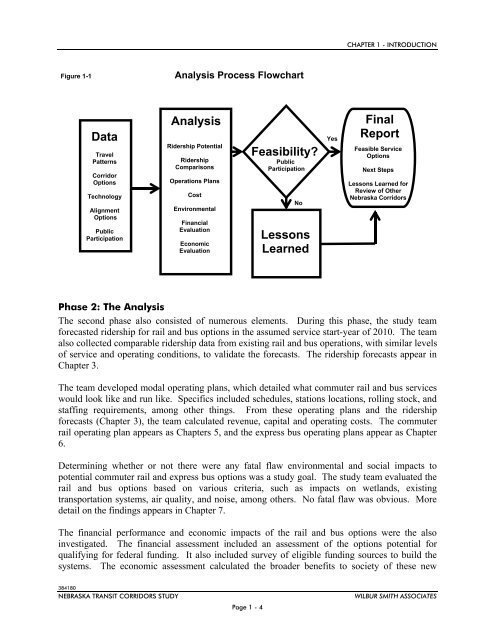NTRAC Final Study - Nebraska Department of Roads - State of ...
NTRAC Final Study - Nebraska Department of Roads - State of ...
NTRAC Final Study - Nebraska Department of Roads - State of ...
You also want an ePaper? Increase the reach of your titles
YUMPU automatically turns print PDFs into web optimized ePapers that Google loves.
CHAPTER 1 - INTRODUCTION<br />
Figure 1-1<br />
Analysis Process Flowchart<br />
Data<br />
Travel<br />
Patterns<br />
Corridor<br />
Options<br />
Technology<br />
Alignment<br />
Options<br />
Public<br />
Participation<br />
Analysis<br />
Ridership Potential<br />
Ridership<br />
Comparisons<br />
Operations Plans<br />
Cost<br />
Environmental<br />
Financial<br />
Evaluation<br />
Economic<br />
Evaluation<br />
Feasibility?<br />
Public<br />
Participation<br />
No<br />
Lessons<br />
Learned<br />
Yes<br />
<strong>Final</strong><br />
Report<br />
Feasible Service<br />
Options<br />
Next Steps<br />
Lessons Learned for<br />
Review <strong>of</strong> Other<br />
<strong>Nebraska</strong> Corridors<br />
Phase 2: The Analysis<br />
The second phase also consisted <strong>of</strong> numerous elements. During this phase, the study team<br />
forecasted ridership for rail and bus options in the assumed service start-year <strong>of</strong> 2010. The team<br />
also collected comparable ridership data from existing rail and bus operations, with similar levels<br />
<strong>of</strong> service and operating conditions, to validate the forecasts. The ridership forecasts appear in<br />
Chapter 3.<br />
The team developed modal operating plans, which detailed what commuter rail and bus services<br />
would look like and run like. Specifics included schedules, stations locations, rolling stock, and<br />
staffing requirements, among other things. From these operating plans and the ridership<br />
forecasts (Chapter 3), the team calculated revenue, capital and operating costs. The commuter<br />
rail operating plan appears as Chapters 5, and the express bus operating plans appear as Chapter<br />
6.<br />
Determining whether or not there were any fatal flaw environmental and social impacts to<br />
potential commuter rail and express bus options was a study goal. The study team evaluated the<br />
rail and bus options based on various criteria, such as impacts on wetlands, existing<br />
transportation systems, air quality, and noise, among others. No fatal flaw was obvious. More<br />
detail on the findings appears in Chapter 7.<br />
The financial performance and economic impacts <strong>of</strong> the rail and bus options were the also<br />
investigated. The financial assessment included an assessment <strong>of</strong> the options potential for<br />
qualifying for federal funding. It also included survey <strong>of</strong> eligible funding sources to build the<br />
systems. The economic assessment calculated the broader benefits to society <strong>of</strong> these new<br />
384180<br />
NEBRASKA TRANSIT CORRIDORS STUDY<br />
Page 1 - 4<br />
WILBUR SMITH ASSOCIATES

















